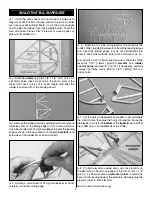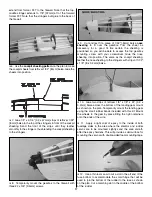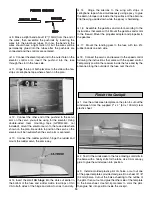
Note: This section is VERY important and must NOT be
omitted! A model that is not properly balanced will be
unstable and possibly unflyable.
❏
1. If using a Great Planes C.G. Machine to balance the Li’l
Poke, adjust the rulers to balance the model 2-5/8" [67mm]
back from the leading edge of the wing. If not using a C.G.
Machine, mark the balance point on the top of the wing on
both sides of the fuselage with 1/8" [3mm] wide striping tape
as shown in the photo. This is the balance point at which the
model should balance for the first flights. After initial trim
flights and when you become more acquainted with the Li’l
Poke, you may experiment by shifting the balance up to 1/4"
[6mm] forward or backward to change its flying
characteristics. Moving the balance point forward may
improve the smoothness and stability, but the model may then
require more speed for takeoff and may become more difficult
to slow down for landing. Moving the balance aft makes the
model more agile with a lighter “feel”. In any case, start at the
recommended location. Do not at any time balance the model
outside the recommended range.
❏
2. Hook two #32 rubber bands together to double the
length. Hook two more #32 rubber bands together the same
way. Mount the wing to the fuse with the rubber bands.
❏
3. With the model ready to fly and all parts installed
except
for the battery, place the model on a Great Planes
C.G. Machine or lift it at the balance point marked on top of
the wing. Place the battery on the bottom of the model
where required to get it to balance. This is where the battery
pack must be installed in the fuse.
❏
4. Noting where the battery must be mounted inside the
fuselage to achieve the correct C.G., remove the wing and
decide how to mount the battery. If the battery pack crosses
the forward dowel, it should fit between the dowel and the
top deck with a little room to spare. Use your own mounting
method or make a 1-1/4" x 2-1/2" [30 x 65mm]
battery
mount
from leftover 1/16" [1.6mm] balsa to reinforce the top
deck. Glue the battery mount to the top deck. Apply Great
Planes Velcro (GPMQ4480, not included), to the battery and
the battery mount, then mount the battery. Keep in mind that
the battery should be readily removable and should also be
repositionable for C.G. adjustments.
Note:
Only a couple of
1/4" [6mm] wide strips of Velcro are required to secure the
battery—do not use a whole sheet. Otherwise, the battery
may be difficult to remove.
❏
5. Mount the receiver and the speed control to one of the
fuse sides or the top deck with Velcro or double-sided foam
mounting tape.
❏
6. Drill a 1/16" [1.6mm] hole through the bottom of the
fuselage and route the receiver antenna through it. Extend the
antenna and tape it to the bottom of the aft end of the fuse. Be
certain the antenna will not be able to come into contact with
the propeller! Never coil-up the antenna inside the fuselage,
nor cut it. The antenna is tuned to a certain length.
❏
7. Recheck the C.G. to make certain the model balances.
Shift the battery as necessary to achieve the correct C.G.
Balance the Model
PREPARE THE MODEL FOR FLYING
20







































